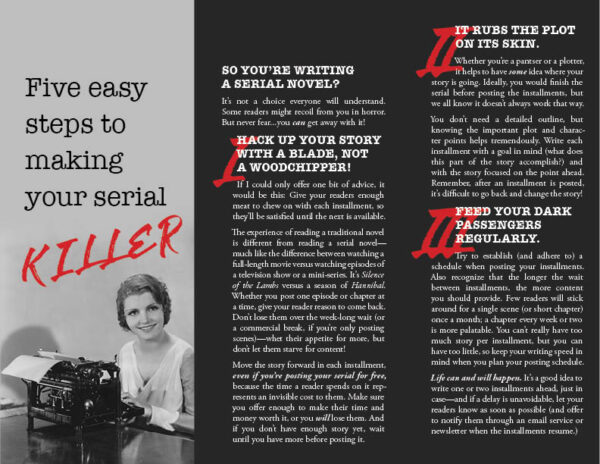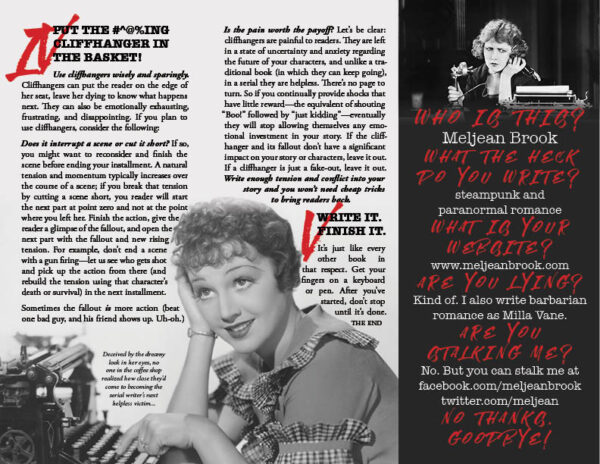Making your serial killer – handout
For the PDF: serial-brochure-web
Just back from RT, and I got a request for the handout I used in the “Making your serial a killer” panel (which was awesome).
Here is the handout — it was originally a tri-fold brochure, but I rearranged the panels so they’re more easily read in JPEG form. YOU CAN CLICK TO ENLARGE THEM. Or I also have the text printed below for those who are vision impaired. If you’d like a PDF that you can print out and fold like a regular brochure, let me know.
So you’re writing a serial novel?
It’s not a choice everyone will understand. Some readers might recoil from you in horror. But never fear…you can get away with it!
I
Hack up your story with a blade, not a woodchipper!
If I could only offer one bit of advice, it would be this: Give your readers enough meat to chew on with each installment, so they’ll be satisfied until the next is available.
The experience of reading a traditional novel is different from reading a serial novel—much like the difference between watching a full-length movie versus watching episodes of a television show or a mini-series. It’s Silence of the Lambs versus a season of Hannibal. Whether you post one episode or chapter at a time, give your reader reason to come back. Don’t lose them over the week-long wait (or a commercial break, if you’re only posting scenes)—whet their appetite for more, but don’t let them starve for content!
Move the story forward in each installment, even if you’re posting your serial for free, because the time a reader spends on it represents an invisible cost to them. Make sure you offer enough to make their time and money worth it, or you will lose them. And if you don’t have enough story yet, wait until you have more before posting it.
II
It rubs the plot on its skin.
Whether you’re a pantser or a plotter, it helps to have some idea where your story is going. Ideally, you would finish the serial before posting the installments, but we all know it doesn’t always work that way.
You don’t need a detailed outline, but knowing the important plot and character points helps tremendously. Write each installment with a goal in mind (what does this part of the story accomplish?) and with the story focused on the point ahead. Remember, after an installment is posted, it’s difficult to go back and change the story!
III
feed your DARK PASSENGERS regularly.
Try to establish (and adhere to) a schedule when posting your installments. Also recognize that the longer the wait between installments, the more content you should provide. Few readers will stick around for a single scene (or short chapter) once a month; a chapter every week or two is more palatable. You can’t really have too much story per installment, but you can have too little, so keep your writing speed in mind when you plan your posting schedule.
Life can and will happen. It’s a good idea to write one or two installments ahead, just in case—and if a delay is unavoidable, let your readers know as soon as possible (and offer to notify them through an email service or newsletter when the installments resume.)
IV
Put the #^@%ing cliffHanger in the basket!
Use cliffhangers wisely and sparingly.Cliffhangers can put the reader on the edge of her seat, leave her dying to know what happens next. They can also be emotionally exhausting, frustrating, and disappointing. If you plan to use cliffhangers, consider the following:
Does it interrupt a scene or cut it short? If so, you might want to reconsider and finish the scene before ending your installment. A natural tension and momentum typically increases over the course of a scene; if you break that tension by cutting a scene short, you reader will start the next part at point zero and not at the point where you left her. Finish the action, give the reader a glimpse of the fallout, and open the next part with the fallout and new rising tension. For example, don’t end a scene with a gun firing—let us see who gets shot and pick up the action from there (and rebuild the tension using that character’s death or survival) in the next installment.
Sometimes the fallout is more action (beat one bad guy, and his friend shows up. Uh-oh.)
Is the pain worth the payoff? Let’s be clear: cliffhangers are painful to readers. They are left in a state of uncertainty and anxiety regarding the future of your characters, and unlike a traditional book (in which they can keep going), in a serial they are helpless. There’s no page to turn. So if you continually provide shocks that have little reward—the equivalent of shouting “Boo!” followed by “just kidding”—eventually they will stop allowing themselves any emotional investment in your story. If the cliffhanger and its fallout don’t have a significant impact on your story or characters, leave it out. If a cliffhanger is just a fake-out, leave it out. Write enough tension and conflict into your story and you won’t need cheap tricks to bring readers back.
V
WRITE IT. FINISH IT.
It’s just like every other book in that respect. Get your fingers on a keyboard or pen. After you’ve started, don’t stop until it’s done.
the end




